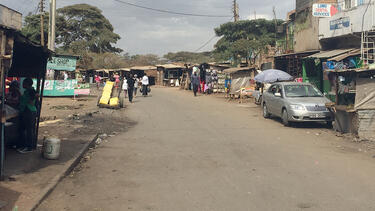Can Mobile Cash Transfers Help the Very Poor Survive COVID-19?
In the developing world, many of those most at risk from the economic effects of COVID-19 are beyond the reach of aid programs. Yale SOM’s Kevin Donovan, a development economist, is studying whether mobile cash transfers can make a difference for residents of Dandora, Kenya, a slum on the outskirts of Nairobi.

A street in Dandora, Kenya, a slum on the outskirts of Nairobi. Photo: Kevin Donovan.
What has the response to COVID-19 been in the area you are studying in Kenya?
Dandora, Kenya, is an extremely dense slum on the outskirts of Nairobi. It’s perhaps most famous for being the site of the only trash dump for Nairobi, which was declared full in 2001. Pollution and respiratory issues are quite a bit higher than normal because of it. I bring this up only to highlight that, all else equal, the effects of a respiratory health crisis are likely to be higher in a place like this.
The broad public health concern is a common one in much of the developing world—poor individuals have no choice but to go out and work to earn a living, a point that’s been highlighted by various Kenyan and international news coverage both in Dandora and in the other slums surrounding Nairobi.
In response, the Kenyan government has implemented a number of policies designed to both dampen the spread of the virus and provide economic relief. The former has included curfews and restrictions of movement into and out of Nairobi. On the latter, the particular methods used to deliver that economic relief (income tax rebates, VAT rebates) make it unlikely to reach those operating on the informal margins of Kenyan society. In our study of female microenterprise owners in Dandora, 83% have not benefited from any government relief programs as of May 12, 2020.
What is the economic impact of COVID-19 in Dandora?
Our work focuses on women who run microenterprises (most have no workers, but at most two) for two reasons. From our previous work in Dandora, we know that Dandoran businesses run by women tend to be less profitable and grow slower than those run by men, and are therefore likely to be most vulnerable to a sharp economic downturn. Second, to the extent women are required to increase duties at home with children out of school, they are likely to have to redirect time away from income-generating activities.
So far, about 15% of businesses have shut down at least temporarily, and more broadly, 98% have seen profit decline over the past month. This is coming from both lower revenue and higher costs – 70% have fewer customers than they used to (in part due to curfews and social distancing requirements) while nearly half are having trouble getting the requisite supplies at their previous prices, if at all.
What are you learning about how cash transfers can help?
The public health crisis has negatively affected Dandoran businesses but economic relief has been slow to reach them. Thus, getting resources to these women is a first-order concern. While there is plenty of broader discussion about the efficacy of cash transfers during this crisis (see my colleague Mushfiq Mobarak’s excellent discussion on such topics), let me instead highlight two aspects of Dandora that we think provide a particular framework where such transfers can help quickly.
The first is that urban poverty is geographically concentrated in slums. Dandoran residents are almost universally poor because anyone who gets sufficiently rich moves out quickly. The second is that cell phone and mobile money coverage is nearly 100%. Combined, these features provide an opportunity to leverage the existing mobile money network to quickly transfer cash to Dandoran residents, while remaining confident the money is going to the most vulnerable members of Kenyan society.
This makes us less worried about some of the policy details that play an important role in other contexts being studied around Yale, including Mushfiq’s work in rural Bangladesh, where the geographic segregation of wealth is not as stark, and Rohini Pande and Charity Troyer Moore’s work in India, where the existing government transfer network may exclude a non-trivial fraction of the poor population.
That said, the context we study is a common one in sub-Saharan Africa with both large slums and ubiquitous mobile money availability, so we expect the results to have broader implications. We delivered the cash transfers the week of May 11, which were equal to about one month’s profit, and will study the impact over the coming weeks and months to hopefully provide some guidance on the impact of such a policy intervention.